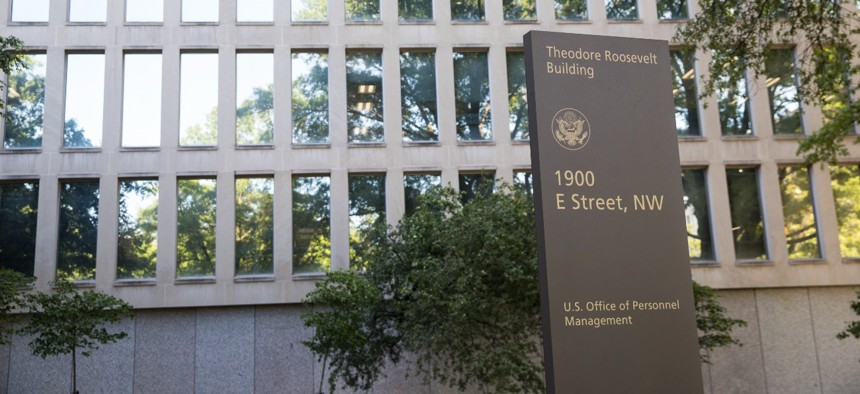
The Office of Personnel Management has always had a role to play following changes to federal personnel policies. Sarah Silbiger/Getty Images
OPM Deputy Touts Agency’s Newly Proactive Stance on Labor Issues
Rob Shriver says recent efforts by officials to mediate labor-management disputes is part of the Office of Personnel Management’s transformation into being the government’s leader on human capital issues.
As federal employee unions began to navigate collective bargaining with agencies during the Biden administration, they noticed something new: the federal government’s HR agency had begun taking a more active role.
Since its inception in 1979, the Office of Personnel Management has always had a role to play following changes to federal personnel policies. Traditionally, that’s meant issuing guidance to agencies on how to implement initiatives.
But over the last two years, union officials have lauded what they described as better follow-through from OPM, with senior officials at the agency acting more proactively and ensuring individual agencies comply with directives concerning labor-management relations.
“It’s just different. You can compare it to the Obama and Clinton administrations,” said Matt Biggs, president of the International Federation of Professional and Technical Engineers last month. “In previous administrations, they might have said some of the right things, but this Biden administration OPM has actually kind of walked the walk. When there are issues at agencies, at least when it comes to IFPTE, OPM is willing to pick up the phone, contact the agencies, and correct, or at least mediate things, to reach some sort of resolution.”
Multiple union leaders recounted instances where they felt agencies were ignoring or slow walking presidential directives, only for OPM Director Kiran Ahuja or newly confirmed Deputy Director Rob Shriver to intercede and mediate a solution.
Shriver, who served as associate director for employee services from January 2021 until he was confirmed to his current role last December, told Government Executive that OPM’s increased action in collective bargaining across government is part of he and Ahuja’s taking to heart recommendations from the National Academy of Public Administration on how to modernize the agency, particularly the proposal that the agency shift from being focused on transactional compliance to becoming a strategic leader for agencies on human capital issues.
“It’s a different role for OPM, and it’s definitely a priority of Director Ahuja that we act in this proactive way,” Shriver said. “We want to be as helpful as we can be to agencies, whether it’s on labor relations or on agencies that got funding under the bipartisan infrastructure law and needed to bring new people on board. We started meeting with those agencies [set to receive funding injections] before that law was even passed about the needs they would have and how OPM could support it proactively. So, this is all in line with that overall approach from the NAPA report and from Director Ahuja.”
OPM’s efforts to serve as a liaison between agencies and their unions originated with President Biden’s executive order rescinding a series of Trump-era orders that sought to diminish labor unions’ role in government and to strip federal workers of their civil service protections, Shriver said. "You know, we did the traditional OPM thing where the EO came out and we issued guidance to agencies, and that’s a very common thing that OPM does,” he said. “But this time, we really drilled in and leaned into the implementation of that guidance . . . I like to think that OPM is this center of excellence when it comes to personnel policy matters, because we have expertise here that goes into the way that we form policy, but we can also use that to really drive change, and that’s what we tried to do here.”
Shriver said OPM is well positioned to take on this newly realized role, due to its frequent contact with political leaders at agencies, career HR staff like chief human capital officers, and unions, who already serve as members of advisory bodies housed within OPM like the Federal Salary Council. And after a tumultuous period for labor relations like the Trump administration was, it’s important to have a neutral party on hand to help build—or rebuild—those collective bargaining relationships.
“Just by the nature of being OPM, we have all this engagement with agencies on a day-to-day basis on all levels of an organization, and we also have this relationship with the leaders of the national unions, because they’re critical stakeholders,” Shriver said. “That involves being as transparent as we can be with information, like when there is new info around the pandemic, for instance, agencies get briefed on that, and then if it’s publicly available we can brief the unions and say, ‘This is the info that agencies got.’ It creates an atmosphere of partnership, and leads to unions trusting OPM as a straight shooter who will tell them when we think the union’s right and tell them when we think they’re off base. And agencies see the same thing.”
Shriver said that relationship-building work really bore fruit as agencies and unions negotiated the terms by which they would begin returning to traditional work sites, despite the anxiety and uncertainty that surrounded the COVID-19 pandemic and the prospect of leaving a maximum-telework stance, particularly amid the rise of the Omicron variant in 2021.
“We had week after week within the interagency process we would meet with agencies and say ‘this is what this means, and start talking to your unions about it now,’” Shriver said. “Start talking about the issues and start working through them now, and maybe you won’t have to do that much bargaining. And [when the Office of Management and Budget’s reentry guidance came out], some agencies told us, ‘We actually worked everything out in a partnership manner so when the OMB guidance came down about the safety plan, we didn’t even have to go to formal bargaining.”







